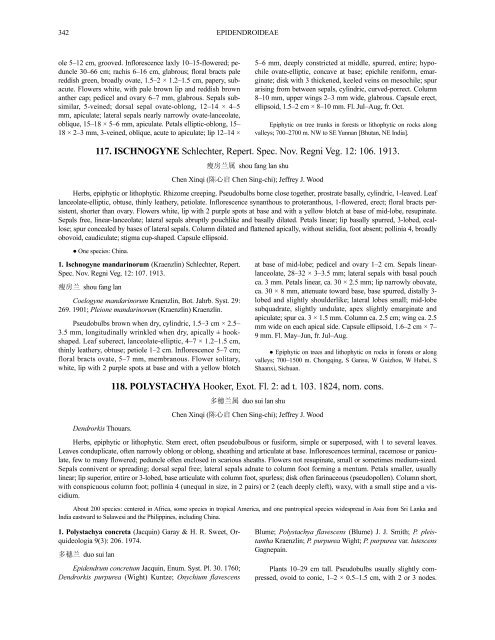You also want an ePaper? Increase the reach of your titles
YUMPU automatically turns print PDFs into web optimized ePapers that Google loves.
342<br />
ole 5–12 cm, grooved. Inflorescence laxly 10–15-flowered; peduncle<br />
30–66 cm; rachis 6–16 cm, glabrous; floral bracts pale<br />
reddish green, broadly ovate, 1.5–2 × 1.2–1.5 cm, papery, subacute.<br />
Flowers white, with pale brown lip and reddish brown<br />
anther cap; pedicel and ovary 6–7 mm, glabrous. Sepals subsimilar,<br />
5-veined; dorsal sepal ovate-oblong, 12–14 × 4–5<br />
mm, apiculate; lateral sepals nearly narrowly ovate-lanceolate,<br />
oblique, 15–18 × 5–6 mm, apiculate. Petals elliptic-oblong, 15–<br />
18 × 2–3 mm, 3-veined, oblique, acute to apiculate; lip 12–14 ×<br />
EPIDENDROIDEAE<br />
5–6 mm, deeply constricted at middle, spurred, entire; hypochile<br />
ovate-elliptic, concave at base; epichile reniform, emarginate;<br />
disk with 3 thickened, keeled veins on mesochile; spur<br />
arising from between sepals, cylindric, curved-porrect. Column<br />
8–10 mm, upper wings 2–3 mm wide, glabrous. Capsule erect,<br />
ellipsoid, 1.5–2 cm × 8–10 mm. Fl. Jul–Aug, fr. Oct.<br />
Epiphytic on tree trunks in forests or lithophytic on rocks along<br />
valleys; 700–2700 m. NW to SE Yunnan [Bhutan, NE India].<br />
117. ISCHNOGYNE Schlechter, Repert. Spec. Nov. Regni Veg. 12: 106. 1913.<br />
瘦房兰属 shou fang lan shu<br />
Chen Xinqi (陈心启 Chen Sing-chi); Jeffrey J. Wood<br />
Herbs, epiphytic or lithophytic. Rhizome creeping. Pseudobulbs borne close together, prostrate basally, cylindric, 1-leaved. Leaf<br />
lanceolate-elliptic, obtuse, thinly leathery, petiolate. Inflorescence synanthous to proteranthous, 1-flowered, erect; floral bracts persistent,<br />
shorter than ovary. Flowers white, lip with 2 purple spots at base and with a yellow blotch at base of mid-lobe, resupinate.<br />
Sepals free, linear-lanceolate; lateral sepals abruptly pouchlike and basally dilated. Petals linear; lip basally spurred, 3-lobed, ecallose;<br />
spur concealed by bases of lateral sepals. Column dilated and flattened apically, without stelidia, foot absent; pollinia 4, broadly<br />
obovoid, caudiculate; stigma cup-shaped. Capsule ellipsoid.<br />
● One species: China.<br />
1. Ischnogyne mandarinorum (Kraenzlin) Schlechter, Repert.<br />
Spec. Nov. Regni Veg. 12: 107. 1913.<br />
瘦房兰 shou fang lan<br />
Coelogyne mandarinorum Kraenzlin, Bot. Jahrb. Syst. 29:<br />
269. 1901; Pleione mandarinorum (Kraenzlin) Kraenzlin.<br />
Pseudobulbs brown when dry, cylindric, 1.5–3 cm × 2.5–<br />
3.5 mm, longitudinally wrinkled when dry, apically ± hookshaped.<br />
Leaf suberect, lanceolate-elliptic, 4–7 × 1.2–1.5 cm,<br />
thinly leathery, obtuse; petiole 1–2 cm. Inflorescence 5–7 cm;<br />
floral bracts ovate, 5–7 mm, membranous. Flower solitary,<br />
white, lip with 2 purple spots at base and with a yellow blotch<br />
Dendrorkis Thouars.<br />
at base of mid-lobe; pedicel and ovary 1–2 cm. Sepals linearlanceolate,<br />
28–32 × 3–3.5 mm; lateral sepals with basal pouch<br />
ca. 3 mm. Petals linear, ca. 30 × 2.5 mm; lip narrowly obovate,<br />
ca. 30 × 8 mm, attenuate toward base, base spurred, distally 3lobed<br />
and slightly shoulderlike; lateral lobes small; mid-lobe<br />
subquadrate, slightly undulate, apex slightly emarginate and<br />
apiculate; spur ca. 3 × 1.5 mm. Column ca. 2.5 cm; wing ca. 2.5<br />
mm wide on each apical side. Capsule ellipsoid, 1.6–2 cm × 7–<br />
9 mm. Fl. May–Jun, fr. Jul–Aug.<br />
● Epiphytic on trees and lithophytic on rocks in forests or along<br />
valleys; 700–1500 m. Chongqing, S Gansu, W Guizhou, W Hubei, S<br />
Shaanxi, Sichuan.<br />
118. POLYSTACHYA Hooker, Exot. Fl. 2: ad t. 103. 1824, nom. cons.<br />
多穗兰属 duo sui lan shu<br />
Chen Xinqi (陈心启 Chen Sing-chi); Jeffrey J. Wood<br />
Herbs, epiphytic or lithophytic. Stem erect, often pseudobulbous or fusiform, simple or superposed, with 1 to several leaves.<br />
Leaves conduplicate, often narrowly oblong or oblong, sheathing and articulate at base. Inflorescences terminal, racemose or paniculate,<br />
few to many flowered; peduncle often enclosed in scarious sheaths. Flowers not resupinate, small or sometimes medium-sized.<br />
Sepals connivent or spreading; dorsal sepal free; lateral sepals adnate to column foot forming a mentum. Petals smaller, usually<br />
linear; lip superior, entire or 3-lobed, base articulate with column foot, spurless; disk often farinaceous (pseudopollen). Column short,<br />
with conspicuous column foot; pollinia 4 (unequal in size, in 2 pairs) or 2 (each deeply cleft), waxy, with a small stipe and a viscidium.<br />
About 200 species: centered in Africa, some species in tropical America, and one pantropical species widespread in Asia from Sri Lanka and<br />
India eastward to Sulawesi and the Philippines, including China.<br />
1. Polystachya concreta (Jacquin) Garay & H. R. Sweet, Orquideologia<br />
9(3): 206. 1974.<br />
多穗兰 duo sui lan<br />
Epidendrum concretum Jacquin, Enum. Syst. Pl. 30. 1760;<br />
Dendrorkis purpurea (Wight) Kuntze; Onychium flavescens<br />
Blume; Polystachya flavescens (Blume) J. J. Smith; P. pleistantha<br />
Kraenzlin; P. purpurea Wight; P. purpurea var. lutescens<br />
Gagnepain.<br />
Plants 10–29 cm tall. Pseudobulbs usually slightly compressed,<br />
ovoid to conic, 1–2 × 0.5–1.5 cm, with 2 or 3 nodes.
















